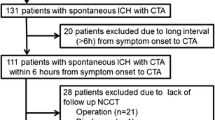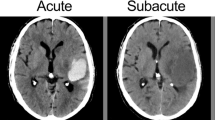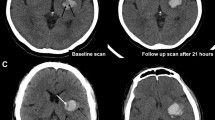Abstract
Purpose
To assess the association between non-contrast computed tomography (NCCT) hematoma markers and the dynamic spot sign on computed tomography perfusion (CTP), and their associations with hematoma expansion, clinical outcome, and in-hospital mortality.
Methods
Patients who presented with intracerebral hemorrhage (ICH) to a stroke center over an 18-month period and underwent baseline NCCT and CTP, and a follow-up NCCT within 24 h after the baseline scan were included. The initial and follow-up hematoma volumes were calculated. Two raters independently assessed the baseline NCCT for hematoma markers and concurrently assessed the CTP for the dynamic spot sign. Univariate and multivariate logistic regression analyses were performed to assess the association between the hematoma markers and the dynamic spot sign, adjusting for known ICH expansion predictors.
Results
Eighty-five patients were included in our study and 55 patients were suitable for expansion analysis. Heterogeneous density was the only NCCT hematoma marker to be associated with the dynamic spot sign after multivariate analysis (odds ratio, 58.61; 95% confidence interval, 9.13–376.05; P < 0.001). The dynamic spot sign was present in 22 patients (26%) and significantly predicted hematoma expansion (odds ratio, 36.6; 95% confidence interval, 2.51–534.2; P = 0.008). All patients with a spot sign had a swirl sign. A co-located hypodensity and spot sign was significantly associated with in-hospital mortality (odds ratio, 6.17; 95% confidence interval, 1.09–34.78; P = 0.039).
Conclusion
Heterogeneous density and swirl sign are associated with the dynamic spot sign. The dynamic spot sign is a stronger predictor than NCCT hematoma markers of significant hematoma expansion. A co-located spot sign and hypodensity predicts in-hospital mortality.





Similar content being viewed by others
Change history
24 September 2022
A Correction to this paper has been published: https://doi.org/10.1007/s00234-022-03055-z
References
Demchuk M et al (2012) “Prediction of haematoma growth and outcome in patients with intracerebral haemorrhage using the CT-angiography spot sign (PREDICT): a prospective observational study”, (in eng). Lancet Neurol 11(4):307–314. https://doi.org/10.1016/s1474-4422(12)70038-8
Boulouis G et al (2016) “Association between hypodensities detected by computed tomography and hematoma expansion in patients with intracerebral hemorrhage”, (in eng). JAMA Neurol 73(8):961–968. https://doi.org/10.1001/jamaneurol.2016.1218
Broderick JP, Brott TG, Duldner JE, Tomsick T, Huster G (1993) “Volume of intracerebral hemorrhage. A powerful and easy-to-use predictor of 30-day mortality”, (in eng). Stroke 24(7):987–93. https://doi.org/10.1161/01.str.24.7.987
Davis SM et al (2006) “Hematoma growth is a determinant of mortality and poor outcome after intracerebral hemorrhage”, (in eng). Neurology 66(8):1175–1181. https://doi.org/10.1212/01.wnl.0000208408.98482.99
Al-Shahi Salman R et al (2018) “Absolute risk and predictors of the growth of acute spontaneous intracerebral haemorrhage: a systematic review and meta-analysis of individual patient data”, (in eng). Lancet Neurol 17(10):885–894. https://doi.org/10.1016/s1474-4422(18)30253-9
Morotti A et al (2019) “Standards for detecting, interpreting, and reporting noncontrast computed tomographic markers of intracerebral hemorrhage expansion”, (in eng). Ann Neurol 86(4):480–492. https://doi.org/10.1002/ana.25563
Barras CD et al (2009) “Density and shape as CT predictors of intracerebral hemorrhage growth”, (in eng). Stroke 40(4):1325–1331. https://doi.org/10.1161/strokeaha.108.536888
Brouwers HB et al (2014) “Predicting hematoma expansion after primary intracerebral hemorrhage”, (in eng). JAMA Neurol 71(2):158–164. https://doi.org/10.1001/jamaneurol.2013.5433
Li Q et al (2015) “Blend sign on computed tomography: novel and reliable predictor for early hematoma growth in patients with intracerebral hemorrhage”, (in eng). Stroke 46(8):2119–2123. https://doi.org/10.1161/strokeaha.115.009185
Li Q et al (2016) “Black hole sign: novel imaging marker that predicts hematoma growth in patients with intracerebral hemorrhage”, (in eng). Stroke 47(7):1777–1781. https://doi.org/10.1161/strokeaha.116.013186
Wei Y et al (2020) “Island sign predicts hematoma expansion and poor outcome after intracerebral hemorrhage: a systematic review and meta-analysis”, (in eng). Front Neurol 11:429. https://doi.org/10.3389/fneur.2020.00429
Morotti A, Arba F, Boulouis G, Charidimou A (2020) “Noncontrast CT markers of intracerebral hemorrhage expansion and poor outcome: a meta-analysis”, (in eng). Neurology 95(14):632–643. https://doi.org/10.1212/wnl.0000000000010660
Boulouis G, Morotti A, Charidimou A, Dowlatshahi D, Goldstein JN (2017) “Noncontrast computed tomography markers of intracerebral hemorrhage expansion”, (in eng). Stroke 48(4):1120–1125. https://doi.org/10.1161/strokeaha.116.015062
Sun SJ et al (2013) “‘Dynamic spot sign’ on CT perfusion source images predicts haematoma expansion in acute intracerebral haemorrhage”, (in eng). Eur Radiol 23(7):1846–1854. https://doi.org/10.1007/s00330-013-2803-4
Romero JM et al (2013) “Prospective validation of the computed tomographic angiography spot sign score for intracerebral hemorrhage”, (in eng). Stroke 44(11):3097–3102. https://doi.org/10.1161/strokeaha.113.002752
Rodriguez-Luna D et al (2017) “Multiphase CT angiography improves prediction of intracerebral hemorrhage expansion”, (in eng). Radiology 285(3):932–940. https://doi.org/10.1148/radiol.2017162839
Chung HS et al (2020) “Distribution and predictive performance of the temporal phase of dynamic spot sign appearance in acute intracerebral hemorrhage”, (in eng). PLoS ONE 15(8):e0236196. https://doi.org/10.1371/journal.pone.0236196
Ovenden CD, Hiwase A, Gyi AA, Abou-Hamden A, Kleinig T (2022) “The predictive accuracy of the delayed spot sign for haematoma expansion in spontaneous supratentorial intracerebral haemorrhage: a systematic review and meta-analysis”, (in eng). J Stroke Cerebrovasc Dis 31(5):106379. https://doi.org/10.1016/j.jstrokecerebrovasdis.2022.106379
Koculym A, Huynh TJ, Jakubovic R, Zhang L, Aviv RI (2013) “CT perfusion spot sign improves sensitivity for prediction of outcome compared with CTA and postcontrast CT”, (in eng). AJNR Am J Neuroradiol 34(5):965–70, s1. https://doi.org/10.3174/ajnr.A3338
Tsukabe A et al (2014) “Prevalence and diagnostic performance of computed tomography angiography spot sign for intracerebral hematoma expansion depend on scan timing”, (in eng). Neuroradiology 56(12):1039–1045. https://doi.org/10.1007/s00234-014-1430-3
Chakraborty S et al (2014) “Dynamic characterization of the CT angiographic ‘spot sign’”, (in eng). PLoS ONE 9(3):e90431. https://doi.org/10.1371/journal.pone.0090431
Kothari RU et al (1996) “The ABCs of measuring intracerebral hemorrhage volumes”, (in eng). Stroke 27(8):1304–1305. https://doi.org/10.1161/01.str.27.8.1304
Armitage P, Berry G, Matthews J (2002) “Statistical methods in medical research”, 4th Ed. Blackwell Science Ltd, Oxford, pp 134–137
Park BK, Kwak HS, Chung GH, Hwang SB (2019) “Diagnostic value of swirl sign on noncontrast computed tomography and spot sign on computed tomographic angiography to predict intracranial hemorrhage expansion”, (in eng). Clin Neurol Neurosurg 182:130–135. https://doi.org/10.1016/j.clineuro.2019.05.013
Wada R et al (2007) “CT angiography ‘spot sign’ predicts hematoma expansion in acute intracerebral hemorrhage”, (in eng). Stroke 38(4):1257–1262. https://doi.org/10.1161/01.STR.0000259633.59404.f3
Morotti A et al (2018) “Integration of computed tomographic angiography spot sign and noncontrast computed tomographic hypodensities to predict hematoma expansion”, (in eng). Stroke 49(9):2067–2073. https://doi.org/10.1161/strokeaha.118.022010
Wang B et al (2016) “Timing of occurrence is the most important characteristic of spot sign”, (in eng). Stroke 47(5):1233–1238. https://doi.org/10.1161/strokeaha.116.012697
Author information
Authors and Affiliations
Contributions
Study conception and design, material preparation, data collection, and analysis were performed by Michael Truong and Christen Barras. The first draft of the manuscript was written by Michael Truong. All authors commented on previous versions of the manuscript. All authors read and approved the final manuscript.
Corresponding author
Ethics declarations
Funding
No funds, grants, or other support was received for the research and authorship of this manuscript.
Conflicts of interest
The authors have no relevant financial or non-financial interests to disclose.
Ethics approval
Approval was obtained from the Central Adelaide Local Health Network ethics committee. The procedures used in this study are in accordance with the ethical standards of the 1964 Declaration of Helsinki and its later amendments.
Consent
Patient consent was not required due to the low risk, retrospective nature of the research.
Additional information
Publisher's note
Springer Nature remains neutral with regard to jurisdictional claims in published maps and institutional affiliations.
The original online version of this article was revised: Originally, the article was published with error. Table 1 footer were missing during online publication. This has been added now.
Rights and permissions
Springer Nature or its licensor holds exclusive rights to this article under a publishing agreement with the author(s) or other rightsholder(s); author self-archiving of the accepted manuscript version of this article is solely governed by the terms of such publishing agreement and applicable law.
About this article
Cite this article
Truong, M.Q., Metcalfe, A.V., Ovenden, C.D. et al. Intracerebral hemorrhage markers on non-contrast computed tomography as predictors of the dynamic spot sign on CT perfusion and associations with hematoma expansion and outcome. Neuroradiology 64, 2135–2144 (2022). https://doi.org/10.1007/s00234-022-03032-6
Received:
Accepted:
Published:
Issue Date:
DOI: https://doi.org/10.1007/s00234-022-03032-6




